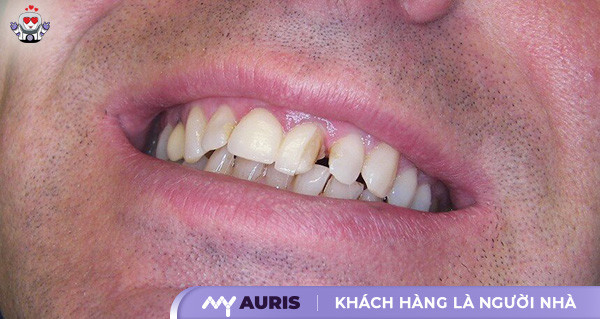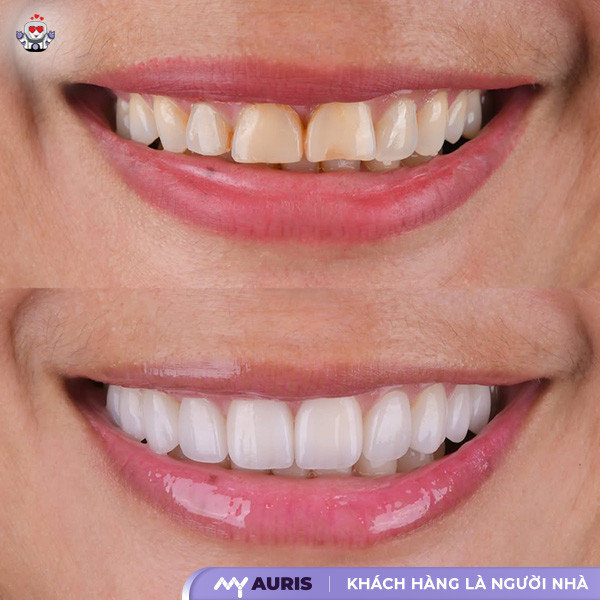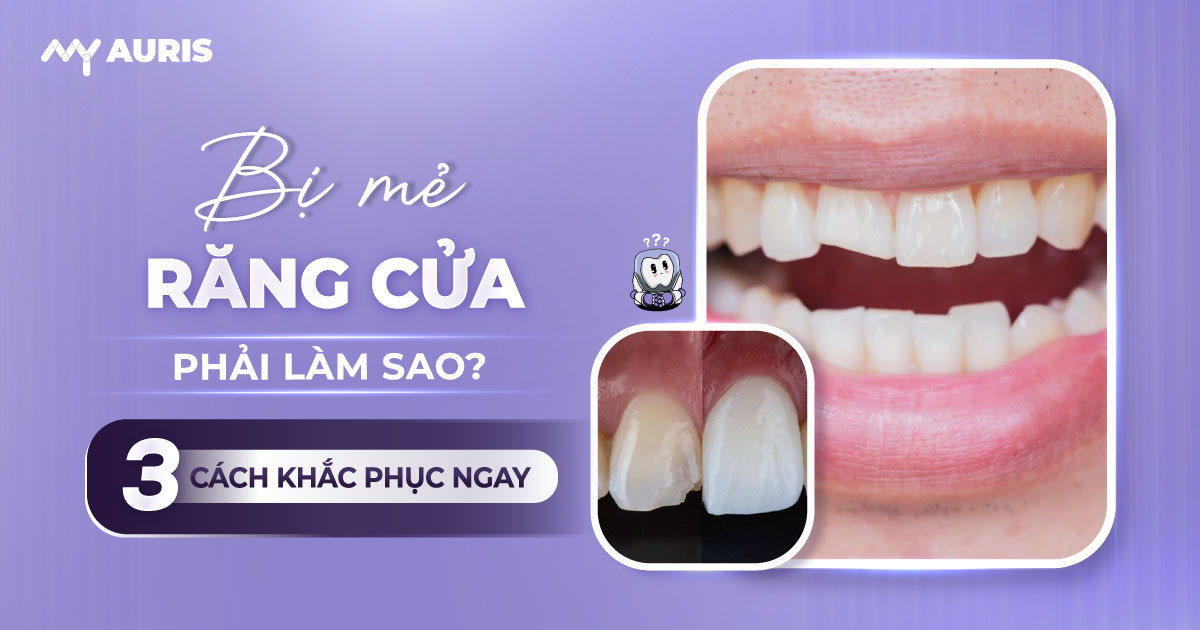Your teeth, especially the front teeth (incisors), play a crucial role in shaping facial aesthetics and expressing confidence in communication. However, when a front tooth is chipped, it not only affects your appearance but also causes difficulty in chewing, and can lead to many long-term oral health consequences. So, what should you do to effectively, safely, and aesthetically fix a chipped front tooth? A dentist will share detailed solutions in the content below.
What Causes Chipped Front Teeth?
The surface of our teeth is covered by enamel – a hard, protective layer that is, however, susceptible to damage if exposed to strong external forces. Chipped teeth usually occur when enamel is damaged due to impact, falls, or biting on hard objects, causing the tooth structure to break. This condition is common in front teeth – the area most easily affected by impact, especially the incisal edge, leading to sharp or jagged teeth, which can be uncomfortable and potentially injure soft tissues in the mouth.
This is a common oral injury not only in adults but also prevalent in young children, affecting aesthetics, chewing function, and daily communication. So, what causes chipped front teeth? Let’s find out in detail:
Damage from external forces such as accidents, falls, or strong impacts to the mouth can cause teeth to chip, leading to pain and discomfort. Additionally, biting hard objects like bottle caps, ice cubes, bones, or hard candies is also a common cause of chipped teeth.
Teeth lacking calcium, fluoride, and other minerals become brittle, more prone to breaking or chipping than usual. Nutrient deficiency weakens enamel, causing it to lose its protective ability against external impacts.
Front tooth decay weakens the tooth structure from within, making the tooth prone to cracking, breaking, and even fracturing, leading to continuous pain and increasing the risk of spreading bacteria that cause other oral diseases.
Foods rich in sugar and acid, such as grapefruit, oranges, lemons, soft drinks, and alcohol, can damage tooth enamel, causing it to erode quickly and become more susceptible to chipping. Unhealthy eating habits directly affect oral health.
Unconsciously grinding teeth together at night creates significant friction, causing enamel to wear down over time. If prolonged, this can make teeth prone to chipping, especially the front teeth.
Chipped front teeth are something no one desires, as it not only affects the beauty of your teeth and face but also makes you lose confidence and hesitate to communicate with others. More seriously, if not treated promptly, you could lose your front teeth, causing difficulty in eating and loss of appetite.

What to Do When a Front Tooth is Chipped?
A chipped front tooth not only affects aesthetics but also causes difficulty in chewing and communication. So, what should you do if a front tooth is chipped? Depending on the extent of the damage, the dentist will advise on suitable tooth restoration solutions such as: dental bonding, dental crowns, or porcelain veneers for chipped teeth. Each method has its own advantages and disadvantages, suitable for specific situations.
Dental Bonding
Dental bonding is a quick and cost-effective solution for restoring chipped front teeth in both the upper and lower jaws. The bonding process is quite simple: the dentist cleans the tooth, then applies composite material and uses a curing light to harden it. This method helps restore tooth tissue and improve chewing function.
Advantages:
Quick procedure time (30 minutes): You can complete the dental bonding in just one short appointment.
Affordable cost (200,000 – 1 million VND/tooth): This is the most economical option among the three methods.
High aesthetic appeal (color similar to natural teeth): Composite dental bonding material has a color similar to natural teeth, making it difficult to detect with the naked eye.

Disadvantages:
Lower longevity (needs replacement every 3 – 5 years): The filling can chip or wear down over time.
Filling discoloration: Due to the effects of food and beverages, the filling may become stained.
Dental bonding is a suitable option if you want to fix a chipped front tooth quickly and affordably. However, if you are concerned about long-term aesthetics for a prominent area like the front teeth, carefully consider other methods.
Dental Crowns
Dental crowning is an increasingly popular tooth restoration method due to its optimal aesthetics for all cases of chipped front teeth. Before placing the crown, the tooth will be reshaped to a specific proportion, ensuring the crown fits without feeling bulky. The time required for dental crowning for a chipped front tooth is usually 2 – 4 days.
Advantages:
Restores chipped teeth to their original shape, with color similar to natural teeth: Creates a natural and harmonious smile.
Biocompatible, safe, and does not irritate tooth tissue: Uses biocompatible ceramic materials safe for health.
Withstands high chewing forces, close to natural tooth strength: Ensures good chewing function.
Provides comprehensive tooth protection, reducing the risk of future chipping or breakage: Enhances tooth durability.
Long-lasting results (can last a lifetime) & Reasonable cost: A one-time investment for long-term effectiveness.
Various price options: Caters to diverse customer needs.
Painless, minimally invasive: The procedure is gentle and comfortable.

Porcelain Veneers for Chipped Teeth
Porcelain veneering for chipped teeth is a technique that covers and encloses the chipped area with a veneer that is 0.2 mm – 0.5 mm thick. Depending on the location of the chipped tooth, the veneer can cover a part or the entire front surface of the tooth. The veneering technique is similar to dental crowning, but the dentist only removes a small portion of the enamel instead of extensive grinding, making the procedure simpler.
Advantages:
Enhances the aesthetics of teeth and face: The color of the porcelain is similar to natural teeth, making veneers difficult to detect.
Restores the tooth’s original integrity: Restores the tooth’s shape and function.
Quick procedure time & Long-lasting results: Saves time and provides durable outcomes.
Maximally preserves natural tooth structure: Less invasive compared to dental crowning.

What Does a Chipped Tooth Mean?
What a chipped tooth signifies is a concern for many. People often worry and think negatively. According to East Asian physiognomy, a chipped tooth is considered a bad omen, not bringing good luck in the near future. It is believed that one might soon experience losses such as financial drain, loss of wealth, and declining health, etc.
However, these are merely beliefs held by those who trust in spirituality, leading to their worries. If these things are mentioned to those who believe in science, they would immediately dismiss them. Scientifically, a chipped tooth is not an omen but rather a silent signal, a warning that your body and oral health have issues that need attention and care. When a tooth is chipped, it might indicate poor oral health, weak teeth, or possibly a calcium deficiency, making them prone to breaking, fracturing, or chipping.
Additionally, chipped teeth can be caused by various other factors, such as:
- Tooth erosion due to exposure to chemicals, highly acidic foods, combined with brushing too vigorously, using hard-bristled toothbrushes, or abrasive toothpaste, can lead to significant tooth wear, weakened enamel, and thus make teeth prone to chipping.
- Chipped teeth due to accidents, impacts, sports injuries, or biting on objects, eating overly hard foods.
- Suffering from oral diseases such as tooth decay, loss of dental fillings, gingivitis, etc., will increase the risk of chipped teeth.
- Individuals with acid reflux also experience weakened teeth, making them susceptible to chipping.
- People with congenital calcium deficiency or insufficient calcium intake in their diet also have weak teeth prone to chipping.
Therefore, if you’re wondering what a chipped tooth signifies, it’s a reminder to visit a dentist for an early check-up and oral health examination. Don’t hesitate and worry about bad omens, thus delaying the treatment and resolution of oral problems. Identifying the cause of a chipped tooth as early as possible is crucial for the dentist to recommend the most suitable corrective solution.
Guide on How to Handle a Chipped Front Tooth
Upon noticing signs of a chipped front tooth, you need to act quickly and correctly to protect both the front tooth and your overall health. Here are the dental standard steps for handling a chipped front tooth:
Promptly spit out any broken fragments: If there are sharp fragments, remove them immediately to prevent injury to the oral cavity or ingestion into the digestive system, which could lead to serious consequences.
Keep the broken tooth fragment in a sealed container: This is very important because, in some cases, the dentist may be able to reattach the fragment to the tooth, effectively restoring the front tooth’s shape and function.
Rinse your mouth with saline solution: This is an initial treatment step to help limit infection and soothe the injured area. Afterward, chew carefully, avoiding contact with the chipped tooth edge to prevent the situation from worsening.
Promptly visit a reputable dental clinic: Having a dentist examine and advise on an effective corrective solution is a crucial factor. Depending on the extent of the damage, the dentist will propose treatment options such as dental bonding, crowning, or suitable aesthetic restoration.





